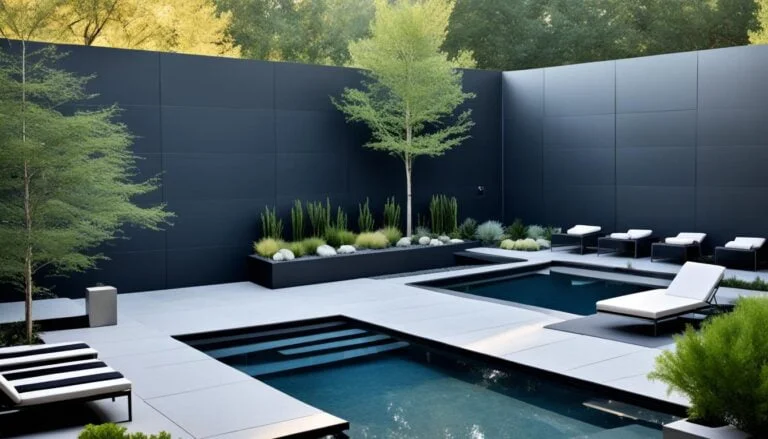Vertical garden structures offer an innovative solution for transforming urban spaces into lush, eco-friendly oases. In today’s concrete jungle, where green space is limited and the connection with nature is often lost, these structures provide a breath of fresh air and a touch of nature in the midst of the bustling city.
Creating an eco-friendly oasis in an urban space is now within reach, thanks to the practicality and versatility of vertical gardens. With the ability to maximize greenery in minimal areas, these structures are perfect for sustainable urban gardening. Whether you have a small balcony or a rooftop terrace, vertical gardens can turn any limited space into a thriving, vibrant landscape.
Key Takeaways:
- Vertical garden structures offer a practical solution for sustainable urban gardening.
- These structures maximize greenery in limited urban spaces, creating eco-friendly oases.
- Vertical gardens structures can be implemented in various settings, from balconies to rooftop terraces.
- They provide a connection to nature and contribute to a healthier, more sustainable urban environment.
- Vertical gardening structures allows for creative and innovative landscape design possibilities.
Benefits of Vertical Gardening
Vertical gardening offers numerous benefits, including contributing to eco-friendly landscape design. These structures utilize innovative water conservation techniques and can even incorporate renewable energy sources in eco-gardens. Additionally, vertical gardens provide a habitat for wildlife and support the creation of wildlife habitat gardens.
When it comes to eco-friendly landscape design, vertical gardening is an ideal choice. By utilizing vertical spaces, these gardens maximize plant growth in limited areas, making them a sustainable solution for urban and small-space environments. The vertical structures offer a range of innovative water conservation techniques, such as drip irrigation systems and rainwater harvesting, minimizing water waste and promoting efficient watering practices.
Furthermore, vertical gardens can incorporate renewable energy sources, such as solar panels or wind turbines, to power lighting or irrigation systems. This integration of renewable energy in eco-gardens aligns with the principles of sustainability and reduces reliance on non-renewable energy sources.
One of the additional benefits of vertical gardening is the creation of wildlife habitat gardens. These gardens provide a refuge for various wildlife species, including birds, butterflies, and other pollinators. By incorporating native plants and creating diverse habitats within the vertical structures, individuals can enhance biodiversity and contribute to the conservation of local ecosystems.
Vertical gardening not only offers aesthetic appeal but also plays a crucial role in promoting eco-friendly practices and creating sustainable urban green spaces. By implementing these innovative techniques and designs, individuals can make a positive impact on the environment and enjoy the many benefits vertical gardening has to offer.
Practical Tips for Building Vertical Gardens
Building a vertical garden can be achieved through various methods. With the advancement of high-tech smart gardening techniques, it is now easier than ever to create space-efficient vertical gardens in urban settings. By incorporating urban permaculture practices and utilizing indoor hydroponic systems, you can maximize productivity and create sustainable green spaces even in limited areas.
Utilizing High-Tech Smart Gardening Techniques
High-tech smart gardening offers a range of innovative solutions for optimizing space efficiency in vertical gardens. By using advanced technologies such as automated irrigation systems and smart sensors, you can ensure that your plants receive the perfect amount of water, light, and nutrients. These systems can be programmed to adjust based on specific plant requirements, enabling you to create a tailored and efficient growing environment. Additionally, smart gardening apps and devices allow you to monitor and control your vertical garden remotely, making it convenient and hassle-free.
Incorporating Urban Permaculture Practices
Urban permaculture practices focus on creating sustainable and productive ecosystems within urban environments. By applying permaculture principles such as companion planting, soil regeneration, and water conservation, you can enhance the productivity and resilience of your vertical garden. Utilizing native and drought-tolerant plants can help reduce water usage and create a habitat for beneficial insects and wildlife. Furthermore, incorporating composting systems and utilizing organic fertilizers can promote soil health and nutrient cycling, ensuring the long-term sustainability of your garden.
Exploring Indoor Hydroponic Systems
Indoor hydroponic systems offer an innovative solution for vertical gardening in limited space environments. By utilizing a soilless growing medium and a nutrient-rich water solution, these systems allow plants to grow vertically without the need for traditional soil. Hydroponic systems can be customized to fit different types of plants and can be easily adjusted for optimal growth conditions. This method is not only space-efficient but also promotes faster growth and higher yields.
By combining high-tech smart gardening techniques, urban permaculture practices, and indoor hydroponic systems, you can create a thriving and sustainable vertical garden in any urban space. The possibilities are endless when it comes to maximizing greenery and embracing the beauty of nature, even in the most limited spaces.
| Vertical Gardening Tips | |
|---|---|
| Utilize automated irrigation systems to ensure optimal watering for plants | |
| Choose native and drought-tolerant plants to reduce water usage | |
| Use smart gardening apps and devices for remote monitoring and control | |
| Incorporate companion planting to enhance biodiversity and pest control | |
| Implement composting systems and organic fertilizers for improved soil health | |
| Explore different types of indoor hydroponic systems for optimal space utilization |
Enhancing Vertical Gardens Structures with Green Roof Ecosystems
Green roof ecosystems offer a unique and sustainable way to enhance vertical gardens. By incorporating these systems, garden enthusiasts can take their urban gardening endeavors to new heights while benefiting from organic composting methods and the growth of a diverse range of plants. Green roof ecosystems not only provide practical advantages but also add a touch of contemporary garden artistry and embrace biophilic design principles, resulting in harmonious and visually appealing environments.
Organic Composting Methods
One of the key benefits of integrating green roof ecosystems into vertical gardens is the facilitation of organic composting. These systems support the decomposition of organic waste materials, such as kitchen scraps and plant trimmings, to produce nutrient-rich compost. This compost can then be used as a natural and chemical-free fertilizer to nourish the plants within the vertical garden, promoting their healthy growth and vitality.
Supporting Plant Growth
Green roof ecosystems create an ideal environment for the growth of various plants in vertical gardens. The natural insulation provided by the green roof helps regulate temperature and moisture levels, creating optimal conditions for plant development. Additionally, the vegetation on the rooftop aids in reducing stormwater runoff, preventing erosion, and mitigating the urban heat island effect, contributing to the overall health and resilience of the vertical garden ecosystem.
Contemporary Garden Artistry
The integration of green roof ecosystems adds an aesthetic element to vertical gardens. The lush and vibrant greenery on the rooftop creates a visually pleasing contrast against the vertical structures, transforming them into captivating works of contemporary garden artistry. The combination of living plants and innovative architectural designs elevates the overall beauty and appeal of the garden, creating an enchanting oasis within the urban landscape.
Embracing Biophilic Design Principles
Green roof ecosystems align with the principles of biophilic design, which aim to create spaces that foster a deep connection with nature. By incorporating natural elements and ecological processes into the vertical garden, biophilic design principles are manifested. The presence of lush vegetation, the sounds of birds chirping, and the soothing scent of blooming flowers evoke a sense of tranquility, improving the overall well-being of individuals who interact with the green roof ecosystem.
Green roof ecosystems truly offer a myriad of benefits for enhancing vertical gardens. From providing organic composting methods to promoting plant growth, while also embracing contemporary garden artistry and biophilic design principles, these systems create a harmonious and natural environment. By incorporating green roof ecosystems into their vertical gardens, urban gardeners can transform their spaces into vibrant, sustainable, and visually stunning green oases.
Incorporating Smart Garden Automation in Vertical Gardens Structures
Smart garden automation technologies offer an exciting opportunity to enhance the efficiency and sustainability of vertical gardens. By integrating these advanced systems, gardeners can automate key maintenance tasks, resulting in easier and more eco-friendly garden management.
One of the key advantages of smart garden automation is the ability to automate watering. With sensors and timers, these systems can ensure that plants receive the right amount of water at optimal times, preventing under or over watering. This not only promotes healthy growth but also conserves water, making it an eco-friendly choice.
In addition to automated watering, smart garden automation can control other essential tasks such as lighting. By incorporating timers or light sensors, vertical gardens can be equipped with the ideal lighting conditions for plant growth. This allows for precise control and energy efficiency, as the lights can be adjusted based on natural lighting levels.
Furthermore, smart garden automation can contribute to eco-friendly garden renovation. Existing gardens can be retrofitted with these systems, transforming them into sustainable and efficient spaces. By upgrading traditional garden systems with automation technologies, gardeners can reduce water waste, save energy, and create a more eco-friendly environment.
Take a look at the table below for a comparison between traditional garden management and smart garden automation:
| Traditional Garden Management | Smart Garden Automation |
|---|---|
| Manual watering | Automated watering based on sensors and timers |
| Fixed lighting | Adjustable lighting based on natural lighting levels |
| Higher water consumption | Water-efficient irrigation system |
| Higher energy consumption | Precise control and energy efficiency |
Incorporating smart garden automation in vertical gardens not only streamlines maintenance but also contributes to a more sustainable and eco-friendly approach to gardening. By leveraging automation technologies, gardeners can achieve optimal plant growth while minimizing water and energy usage.
Conclusion
Vertical garden structures provide a practical and sustainable solution for urban gardening. With their ability to maximize greenery in minimal space, these structures offer endless possibilities for creating thriving and sustainable urban green spaces. By incorporating vertical garden structures, individuals can contribute to eco-friendly landscape design and sustainable urban gardening practices.
One of the key advantages of vertical gardening is the opportunity to utilize innovative water conservation techniques. These structures allow for efficient water usage, minimizing waste and promoting sustainable gardening practices. Additionally, vertical gardens can incorporate renewable energy sources, further enhancing their eco-friendly nature.
Vertical gardens also play a vital role in enhancing biodiversity. By creating wildlife habitat gardens within these structures, individuals can attract and support various forms of wildlife. This not only adds to the beauty of the urban space but also contributes to the preservation of natural ecosystems.
In conclusion, vertical garden structures are a game-changer when it comes to sustainable urban gardening and eco-friendly landscape design. Whether it’s through innovative water conservation techniques, renewable energy integration, or the creation of wildlife habitat gardens, these structures offer a practical and aesthetically pleasing way to transform urban spaces into green oases, benefiting both the environment and the community.
FAQ
What are vertical garden structures?
Vertical garden structures are innovative solutions for transforming urban spaces into lush, eco-friendly oases. They allow for maximum greenery in minimal areas, making them perfect for sustainable urban gardening.
What benefits do vertical gardens offer?
Vertical gardens contribute to eco-friendly landscape design by utilizing innovative water conservation techniques and can even incorporate renewable energy sources in eco-gardens. They also provide a habitat for wildlife and support the creation of wildlife habitat gardens.
How can I build a vertical garden?
There are various methods for building a vertical garden. You can utilize high-tech smart gardening techniques to maximize space efficiency, incorporate urban permaculture practices for sustainability, or use indoor hydroponic systems for limited space environments.
How can I enhance my vertical garden with green roof ecosystems?
Green roof ecosystems can enhance vertical gardens by providing organic composting methods and supporting the growth of various plants. They also incorporate contemporary garden artistry and utilize biophilic design principles for a harmonious and natural environment.
How can I incorporate smart garden automation in my vertical garden?
Smart garden automation technologies can be integrated into vertical gardens, allowing for efficient and eco-friendly garden management. These systems automate watering, lighting, and other maintenance tasks, making it easier to care for your vertical garden. They can also be used to renovate existing gardens, making them more eco-friendly and sustainable.
Why should I consider vertical garden structures?
Vertical garden structures provide a practical and sustainable solution for urban gardening. By incorporating them, you can create eco-friendly landscape designs and contribute to sustainable urban gardening practices. Whether utilizing innovative water conservation techniques, incorporating renewable energy sources, or enhancing biodiversity, vertical gardens offer endless possibilities for creating thriving and sustainable urban green spaces.
















